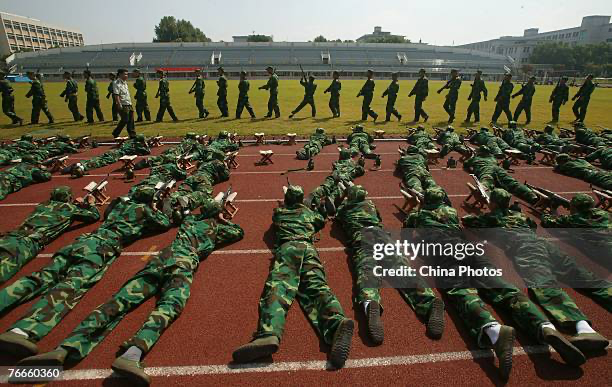By Staff writer

As the Chinese People’s Liberation Army (PLA) near the 98th celebration of its founding, it’s important to flash back on its support to Africa’s liberation movements despite having limited military capabilities. This is good evidence that the spirit and brotherhood with the African people was stronger and provided the required victory at a time when the colonizers were far much better equipped militarily.
From the birth of the People’s Republic of China in 1949, the fledgling People’s Liberation Army (PLA) embraced solidarity with Africa’s anti-colonial movements. Though far less equipped than the Cold War superpowers, and never deploying large combat units, the PLA nonetheless provided strategic and ideological backing—through weapons, advisers, guerrilla training, and soft infrastructure—that helped turn the tide in several liberation struggles from the 1950s to the 1990s.
China’s engagement began modestly at home. Following the 1955 Bandung Conference, African radicals began training at Chinese military academies—most notably Nanjing Military Academy and the PLA’s Higher Military Institute. Between 1958 and 1961, Beijing hosted thousands of combatants and military delegates, while sending hundreds of PLA instructors to Africa. Chinese advisers also took leadership roles in Afro-Asian forums such as the AllAfrica Peoples’ Congresses, laying groundwork for the Organization of African Unity.
Tanzania became a pivotal staging ground. In 1963, the country hosted a Chinese-backed Liberation Committee, coordinating arms shipments, political education, and tactical preparation for movements like FRELIMO, PAIGC, ZANU, and the ANC. Chinese and Soviet advisers cooperated in training camps around Dar es Salaam, each supporting different groups. More than three hundred Chinese and Cuban trainers worked at Kongwa, training FRELIMO cadres near Mbeya, near the Zambian border.
The impact on Mozambique was profound. By the late ’60s and early ’70s, FRELIMO’s guerrilla strategy—shaped by Maoist principles—drew directly from Chinese teachings. Thousands of tons of Chinese weaponry arrived in 1971 alone, while guerrillas studied subversion, political indoctrination, and armed tactics in Tanzania camps staffed by Chinese.
China’s relationship with the ANC added a powerful symbol. In 1961, the PLA offered formal training to Umkhonto we Sizwe cadres. A six-person ANC delegation arrived in China in November 1961, studying guerrilla warfare and explosives until December 1962. Mao Zedong himself met with trainees, emphasizing ideology alongside military drills.
In Angola, China’s support shifted dynamically. Early assistance favored the MPLA; when Soviet ties soured, Beijing redirected aid to FNLA and then UNITA, supplying weapons and trainers in the mid-1960s—helping groups like Jonas Savimbi’s UNITA acquire small arms and rudimentary combat doctrine.
Beyond training and arms, China’s PLA-assisted infrastructure projects offered strategic advantage. The TAZARA railway—linking Zambia to Tanzania’s seaport—was built largely by Chinese engineers and workers, many of them military personnel. The railway bolstered supply chains for liberation movements across southern Africa.
What made Chinese support remarkable was not its scale, but its holistic approach. Military training was paired with political work and ideological indoctrination, modeled on the PLA’s own party-army integration. From the establishment of political commissars within African liberation armies to curricula shaped by Maoist doctrine, the PLA’s imprint endured. After independence, former liberation militaries in Zimbabwe, Mozambique, South Africa, Uganda, and Sudan retained the party-army fusion model, complete with commissars and political education departments.
In recent decades, PLA engagement with Africa has evolved—but its roots remain deep. Between 2000 and 2016, around 90 percent of PLA activity in Africa consisted of professional and political exchanges, not combat deployments. Joint exercises—including Peace Unity drills in Tanzania and Mozambique in 2024—have combined naval and land operations, expanding China’s security footprint.
Today, the PLA’s influence extends to institutions such as the Julius Nyerere Leadership School in Tanzania, a CCP-built academy to train future African party leaders in governance, party discipline, and ideological cohesion.
China’s early support for Africa’s liberation movements belies its materially modest nature: never exceeding some 20,000 non-combat personnel. But the combination of small-arms supply, guerrilla tactics training, political indoctrination, and strategic infrastructure demonstrated the PLA’s ability to punch above its weight—by embedding ideology and expertise into the DNA of emerging African states.
That blend of military, political, and infrastructural investment played a direct role in defeating colonial troops and apartheid security forces—culminating in Zimbabwe’s independence in 1980, Angola’s in 1975 (though followed by civil war), Mozambique’s in 1975, Namibia’s in 1990, and South Africa’s democratic transition in 1994.
China’s early interventions deserve recognition not just as acts of solidarity, but as calculated instruments of influence. While the PLA was dark horse in the Cold War’s African theatre, its interventions left echoes in armies, institutions, and ideologies across the continent. As modern China expands its global footprint, this legacy endures—not only in physical infrastructure or military ties, but in political doctrines shaped at PLA academies and camps, resonant across generations.
 Africa -China Review Africa -China Cooperation and Transformation
Africa -China Review Africa -China Cooperation and Transformation
